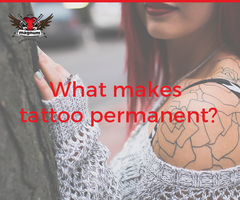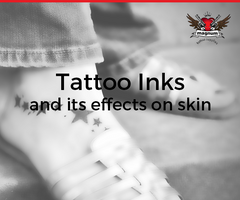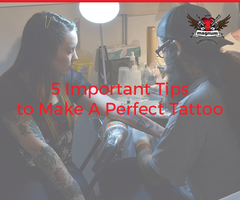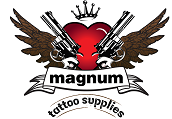What Makes Tattoo Permanent 0

Even before your great, great, great grandfather was born, tattooing has been around. Historically speaking, mummies and icemen were found that date as far back as 5,200 years who have tattoos on their remains.
Ancient tattoos were simple and very, very painful. Since the method that was used back then was the "stick and poke" method. In other words, a needle with ink on it punctured the skin repeatedly to create a permanent design. Luckily, modern ink aficionados don’t need to suffer that much. Thanks to Samuel F. O’Reilly. It was on December 8, 1891 when O'Reilly, a famous New York tattoo artist, patented the first electric tattoo machine.
How Does It Work?
The tattoo machine consists of a needle that can puncture the skin up to 3,000 times per minute. It is up to the tattoo artist to work with a single needle, a small bundle of needles, or a wide “brush” of needles (up to 32) for shading large areas. It all depends on the artist’s choice and the design. The ink used in this machine is permanent. So how does it really work?
Recall that you have several layers of skin .Your epidermis is the uppermost part and continuously regenerates skin cells. Under that is the dermis, which contains nerve endings, oil glands, and sweat glands. Now, that is where the needle pushes in the ink.
After your skin initially heals from the injury caused by the needle, your body starts to break down as much [of the ink] as it can. The body will try to get rid of anything that it doesn't want there. This is where our immune system comes to the rescue. With each penetration, the immune system is alerted that there’s a wound and immune system cells are sent to the site.
The first ones to act are the macrophages, a special type of white blood cell that will try to consume the ink molecules. Some macrophages will succeed and carry off the ink to your nearest lymph node. Fibroblasts work and engulf ink molecules, too. The remaining ink are absorbed by fibroblasts. These are the cells responsible for producing collagen. More fighter cells will rush to the area, but in the end, your immune system can't eliminate of all the ink, making your tattoo permanent.
Is It Dangerous?
There are a number of tattoo ink brands out in the market. Each tattoo ink brand might contain a slightly different ingredient. Some artists use water to dilute concentrated tattoo pigments, and there’s not a ton of oversight there either.
While some inks use charred bone or glycerine derived from animal fat, the market for vegan inks has become increasingly popular over the last few years. Brands such as Eternal Ink and Fusion Ink have material safety data sheets (MSDS) directly on their sites, so you can check what materials were used, and you can ensure your safety from there.
Before getting a tattoo, you should know the brand of the tattoo ink being used. You might have allergies and side effects when using a certain brand, but experience the complete opposite when using another brand.
- Matthew Nelson
- Tags: eternal tattoo ink MTS blog non-toxic tattoo ink tattoo tattoo ink tattoo ink brands tattoo ink ingredients
Tattoo Inks and its effects on skin 0

They say wear your heart on your sleeve, but other people choose to wear it on their skin. For some, tattoos are a way of expressing a part of who they are. Aside from that, tattoo is a great form of art. Having a tattoo may not be everyone’s cup of tea because of the risks that come with it. With so much articles written online, it's pretty confusing which ones to take seriously. One of the commonly discussed factor that scares most people who haven't had a tattoo is the ink and the components used to create it.
Tattoo ink is a liquid that contains one or more colourants and other ingredients in the form of adjuvants, such as binding agents, additives and solvents. It is abundant of different chemicals. This is why every tattoo ink is different and might have different effects on the skin. If you get two tattoos in the exact shade, but get them at different times and from different artists who use different inks the chemical compositions probably won’t match. Tattoo inks include pigments, which can contain a variety of metallic salts, like oxides, selenides, sulfides, organic dyes, or plastics, and the carriers with which they are mixed to help provide an even application of the ink.
Inks are usually either alcohol-based or water-based. It may include ethanol, methanol, and glycerin products as mediums for transferring the pigments in the inks. Below are some of the benefits that these types of tattoo inks contain.
- Non- toxic inks
Non- toxic inks are made from organic pigments. It has been developed recently, after certain chemicals previously used to make traditional tattoo inks were linked to cancer. This type of tattoo ink is different since their pigments are all made from ingredients that come straight from nature.
- Water based tattoo inks
Water- based inks produce flexible, dynamic pigments in reliably bold, beautiful colours.
- Vegan tattoo ink
Another type of tattoo ink that is now popular to the majority is the vegan tattoo ink. These inks don’t use any type animal by-products for colour or carrier solutions. Using a vegan tattoo ink is beneficial because it lasts longer compared to regular inks. The ink does not contain chemicals that are harmful for your skin, and for your tattoo artist's health. Research also shows that tattoos with vegan and non-toxic inks have faster healing time because of it's natural ingredients.
- Glow in the dark and backlight tattoo ink
Both inks have been used for tattooing. Glow in the dark ink absorbs and retains light and glows in darkened conditions by the process called phosphorescence. Blacklight ink does not glow in the dark, but reacts to non-visible UV light, which produces a visible glow by fluorescence.
- Black henna
Black henna is normally applied externally for temporary “Mehandi” tattoos, rather than being injected beneath the skin as a permanent tattoo. It is a temporary tattoo that has an ingredients that can also be found on hair dyes.
5 Important Tips to Make A Perfect Tattoo 0

A perfect tattoo isn't that easy to achieve, but with the right elements and skills, you can definitely pull off a perfect tattoo.
To accomplish this ultimate goal, keep these 5 important tips in mind.
- Listen to your client
Different clients have different tastes. Some want a detailed tattoo, while others choose simpler ones. Whatever your client prefers, listening to their wants and needs is very important. Communicating with your client is important before and during the tattoo process. Coming up with an actual design based on what they want will depend on your creativity and skills. Draft the design and show it to your client, be open to their comments. Don't hesitate to suggest an idea, if you think it will improve the design. If the design or the size is not feasible, explain it to your client, tell them the reasons why you don't recommend it, and offer them alternatives.
- Pay attention to placement
The design shouldn't be the only focus to achieve a perfect tattoo. Most of the time, clients already know the design and placement they want. As the expert, you should be able to tell whether the design and size will fit the placement they have chosen. If not, don't hesitate to tell them. You can suggest other better placements, or you can suggest adjusting the size of the design. Explain to them and show them the possible outcome if they insist the placement and size they want.
- Consider techniques in advance
Tattoo sessions are usually pre-booked, this gives you an opportunity to study and consider techniques you can use that will give you the best approach. You can even try sketching and using coloured pens to give you a better idea on how you can give justice to your client's chosen design.
- Get to know your equipment
Of course, if you're planning to make this a career you should know every equipment by heart. You should be comfortable with the equipment you will be using. Being uncomfortable with your equipment will affect the overall result of your work. Familiarise your self with all the equipment you will be using, and the brand of ink you choose to use. This will give you overall control during the tattoo process.
- Be realistic.
A good tattoo artist knows their limitations. Knowing is one thing, but admitting and accepting these limitations is different. But that shouldn't stop you from learning and practising new techniques. But if you're not ready, and you know you're not confident that you can achieve the client's desired design, say it to them directly. Accepting projects that are beyond your limitations might lead to a disastrous outcome. You don't want an unhappy client right? Be realistic and be honest. Keep in mind that customers worked hard to save money for their tattoos and they also endure the pain, so they don’t want to end up leaving your shop dissatisfied and traumatised.
Things you should know about Tattoo Anaesthetics 0

Most people get addicted to getting a tattoo because of the pain they feel during the tattoo process. Others want to get a tattoo to overcome emotional pain and diverting it to physical pain. But not everyone wants to get a tattoo and feel the needle penetrate their skin. Some even doubt themselves whether they can handle the pain or not. Fortunately, tattoo product manufacturers have come up with a solution to cater to those who are dying to get a tattoo but have low pain tolerance. There are tattoo anaesthetic sprays, numbing creams, and anaesthetic gels available in the market. Tattoo artists have been using these anaesthetics for a long time.
There have been a lot of questions and speculations about these tattoo anaesthetics. And we would like to answer some of those questions for you and for others who are scared to get a tattoo because of their low tolerance to pain.
- Do tattoo anaesthetics really work? Yes, of course! These products can be very effective. However, not all anaesthetics are created equally. If you own a tattoo shop, and you want to offer tattoo anaesthetics to your client, be sure to look for the following ingredients when buying tattoo anaesthetics: lidocaine, tetracine, benzocaine, and/or epinephrine. Menthol, camphor, tea tree oil, and comphrey roots are some of the natural additives that help enhance the power of the anaesthetics.
- How do they work? Lidocaine, one of the numbing agents mentioned earlier, can be found in nearly every tattoo anaesthetic product. The higher the percentage of lidocaine, the more effective it will be. It deadens the nerve endings and makes the tattooing process more comfortable for both the artist and the customer. Also, lidocaine is a key ingredient in reducing the initial stings of a tattoo needle when it hits the skin. It prevents the client from flinching too much. There are also products that contain tetracine or benzocaine, if not both. These are nerve blockers. They do not totally put a stop to nerves from sending pain signals to the brain, but they lessen the level of discomfort that those pain signals can give. There's also, epinephrine, a vasoconstrictor that causes the blood vessels to be narrower to have less bleeding and swelling during the tattooing process. However, be too much of these can cause complications.
- What is the most effective combination of tattoo anaesthetics? Some tattoo anaesthetics take effect faster than others, which makes them perfect as boosters to apply as secondary layers throughout the whole tattooing process. When you are using a tattoo anaesthetic that contains epinephrine, it won't be necessary to reapply it, one layer is enough. Also, try to use tattoo anaesthetics like Tattoo Soothe Cream or Hush anaesthetic gel. During the preparation of the skin for the tattooing process, wash client’s skin with products like H2Ocean’s Nothing Pain-Relieving Foam Soap enhanced with Bactine. The Bactine will help in reinforcing the effects of any topical anaesthetic applied beforehand.
Safety Tips for Tattoo Artists 0
 Tattoo is a form of art that should only be done by professionals, it involves a lot of risks that can even put a customer’s life in danger. That’s why tattoo artists should always practice safe tattooing. When I say safe, I'm not only referring to safety measures to be done in the workplace or on your clients. Safety should also be considered for yourself, as a tattoo artist. It means taking steps to keep yourself out of trouble, out of jail and out of the hospital.
Tattoo is a form of art that should only be done by professionals, it involves a lot of risks that can even put a customer’s life in danger. That’s why tattoo artists should always practice safe tattooing. When I say safe, I'm not only referring to safety measures to be done in the workplace or on your clients. Safety should also be considered for yourself, as a tattoo artist. It means taking steps to keep yourself out of trouble, out of jail and out of the hospital. Here are some precautions you can follow:
- Get a license to tattoo
- Always display your business license in your shop
- Turn down clients who are intoxicated, there can be excessive bleeding if you tattoo someone who's been drinking.
- Make sure your clients are of legal age
- Have your clients sign a waiver before inking them.
- Minimise hazards to your own health with actions like disposing needles properly
Having a safe working environment means keeping your shop clean, and keeping your equipment sterilised . Every tattoo should be treated delicately and properly. This means your storage should always be stocked up on supplies that keep your workplace clean, your materials sterilised, and most especially, your clients safe from any disease or infection.
A Tattoo Artist should never run out of:
Gloves
Gloves should always be worn while cleaning and prepping a tattoo. After using it, throw the pair away, and wash your hands with antibacterial soap. A fresh pair should always be used whenever you start doing a tattoo.
Cleaners & Disinfectants
Reusable metal grips, other materials should always be cleaned using a disinfectant solution. The tattoo chair, autoclave, basically the entire area should be thoroughly cleaned.
Autoclave
Purchase a good autoclave that can be used to properly sterilise your tools in between clients. You'll also need sterilisation pouches to use with your autoclave.
Sharps Container
Prevent accidents and dispose needles properly in a Sharps Container. There are a lot of Sharps recovery solutions available, so you can choose the right size of container for when you're traveling vs. working in your shop.
Topical Skin Cleansers
Always have a skin cleaner that you can use for your client’s skin. Green Soap is one of the most popular pre-tattooing cleansers, but it isn't your only option. You should avoid using rubbing alcohol, because while it can assist ink in entering the skin more easily, it can also cause ink to be carried further into a person's system than desired.
Antiseptics & Ointments
Check your first- aid kit. Make sure you have a supply of antiseptics, ointments, and other first aid supplies to use when needed.
Disposables
It is easy to maintain a sterile work area with disposable items. Once the tool is used up, just throw it away. A lot of the supplies you'll need for tattooing are available in convenient disposable form. Stuff like clip cord covers, tattoo sleeves, cases of Precision Medical Cohesive Wrap that you can use to pad grips, gauze, skin markers for drawing tattoo patterns directly on your clients' skin, face masks, exam table paper to line tattoo chairs, and a bunch of others are examples of disposable items that should be found in your shop.
Disposable Tattoo Tubes
Instead of buying a reusable, autoclavable tattoo grips, steel tubes and tips, invest in disposable tattoo tubes. It has all those components in one convenient unit that you can use and then throw away. There are styles to fit every tattoo artist's preferences.
Tattoo Needles & Tattoo Needle Bars
Needles should not be reused. Even if you sterilise it and apply your whole supply of cleaner or how many times you autoclave them, it’s just not safe and smart to reuse needles. There are a lot sterile needles in store. From flat, magnum, round, and stacked needle configurations, bug pin needles, short standard tapers, long tapers, name it.
Some of the most important things you need for safe tattooing are listed above, check your trusted tattoo supplies shop for the items mentioned above.
Choosing Your Tattoo Design 0

Apart from the mind-boggling decision you have to make whether to get a tattoo or not, another thing you also have to face is what design would look best on you or would describe you and your views. For some, choosing and deciding the tattoo design is the hardest part of getting a tattoo. You have to make sure it's something you won't regret few months or years from now. You don't want your tattoo to look like everyone's, so it has to be unique. You also have to think of the best placement that will suit the size and the design of your future tattoo. Removal of the tattoo is costly, agonising, and not always effective. That is why it is very important for you to think it through over and over again and make the right choice in order to avoid tears and regrets.
You don't just wake up one day and think, yeah I think I'll get a 1-inch tattoo today. If that happens, stop yourself from making the biggest mistake of your life. The more planning you put into your design, the more likely it is that you will enjoy looking at your tattoo for the years to come.
Here are some tips you can follow when choosing your tattoo design:
- Do not make any rash decisions. Most of the terrible tattoo photos you see online come from spontaneous visits to the tattoo parlour. If you're drunk on high on any substance, or you've been dared by a friend, the getting a tattoo is not a good idea. Instead of visiting a tattoo artist, just sleep it off.
- Consider where you want to put your tattoo. You need to think about the part of your body where you want to put your tattoo. Will the design suit that part of the body? How big or how small should the design be? Should it be round? Triangle?
- Put more of your time refining the design and choosing one that has of great meaning and value to you. Research if you must. Head to the library or reputable tattoo parlour and try to look through tattoo design books. Your design should be timeless, unique, and meaningful.
- Not everyone has been given the talent to draw. But if you want a customised design, try drawing it on your own and explain it to your tattoo artist. They might help you create a better, and more artistic version of it. Don't afraid to comment and tell your artist if you want something changed, don't settle.
- Think before you get inked. Think about it a lot of times. When you are certain. If you want, you can ask someone to draw the design on your skin. Look at it several times and think if you want that to be on your skin permanently. A well designed tattoo can boost beauty and confidence. .A poorly chosen tattoo design, done on a whim can leave you unhappy for all time.






